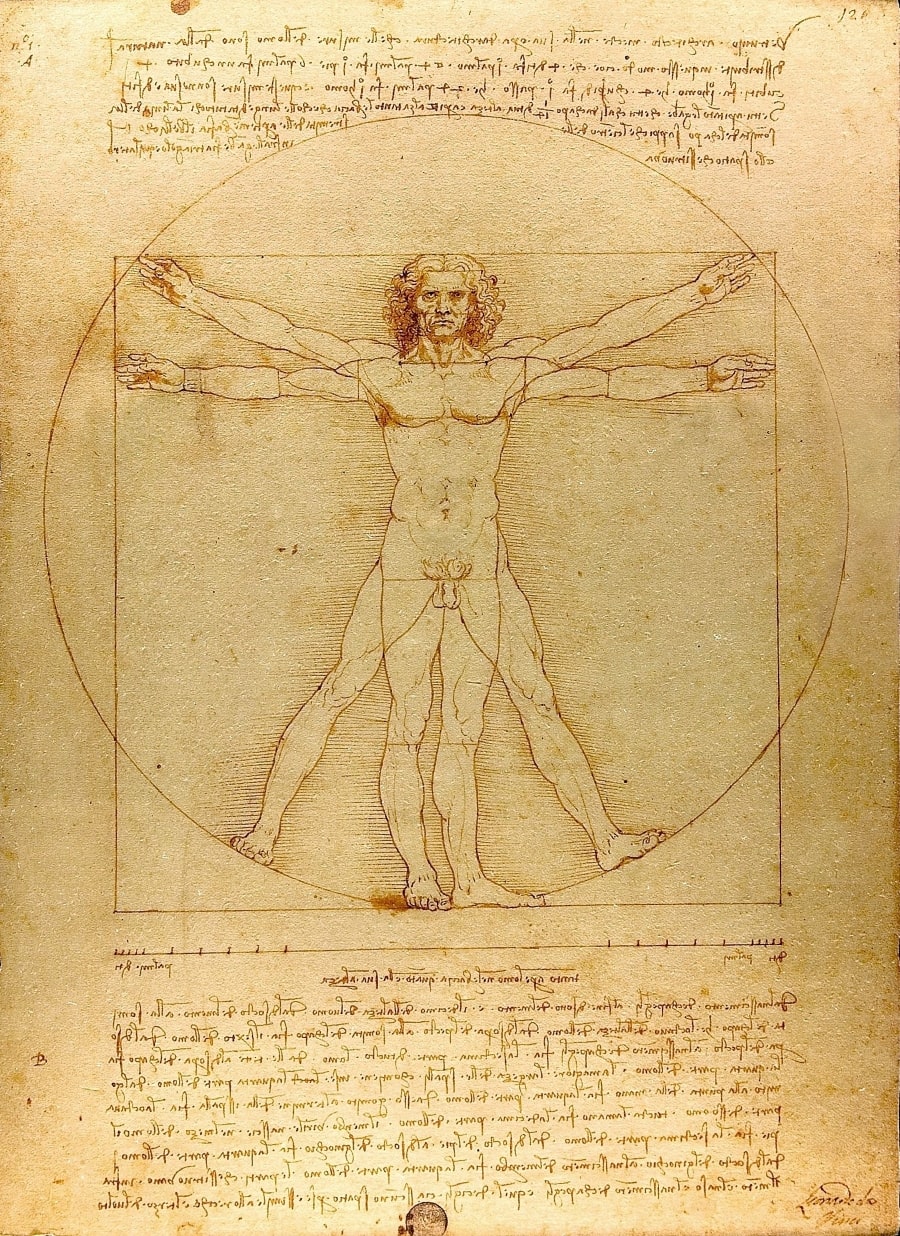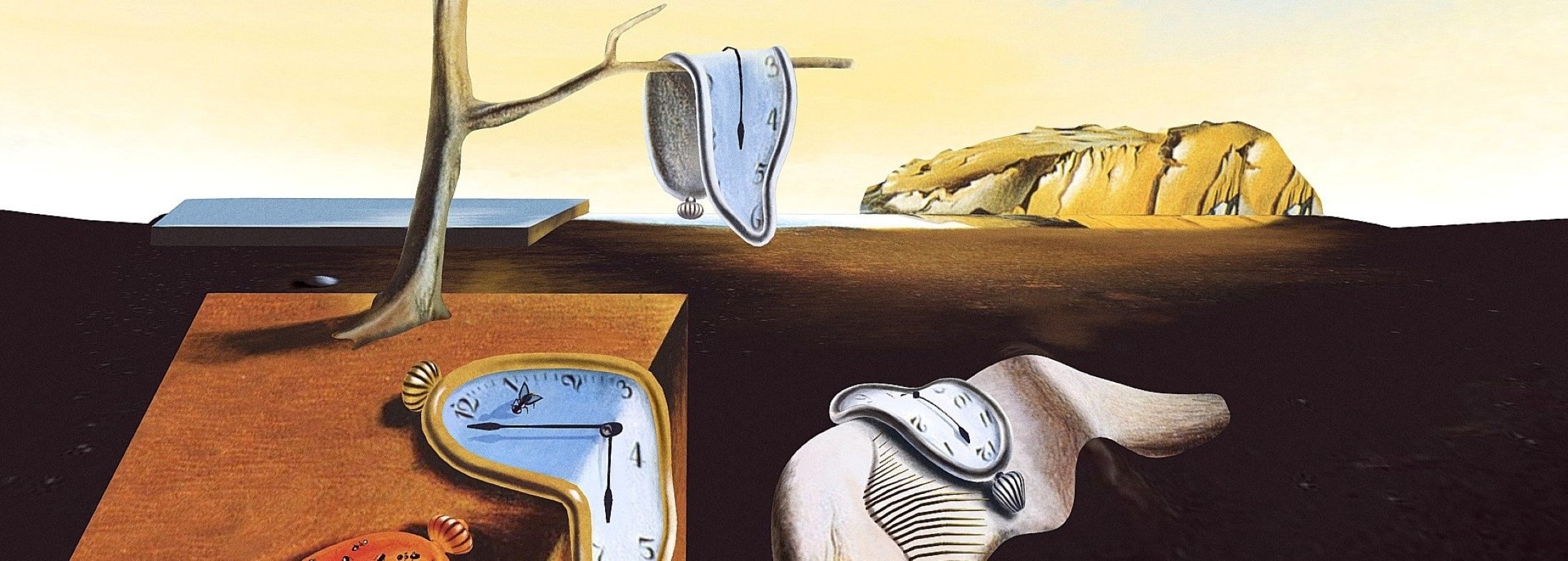
10 most famous artists of all time: Our ultimate list
From Leonardo da Vinci to Salvador Dalí, here we look at 10 of the most famous artists of all time, taking into account their technical skills, the ways in which they innovated to push boundaries, and how their legacy has lived on.
1. Leonardo da Vinci (1452-1519)
Photo 1 - Mona Lisa, Leonardo da Vinci, c.1503-1506. Photo 2 - Vitruvian Man, Leonardo da Vinci, c.1490
A recent discovery has brought this 15th-century Italian artist into modern day headlines. According to Carlo Vecce, an expert on the Renaissance artist, who wrote the historical novel ‘Il Sorriso di Caterina’ (‘Caterina's Smile’), the artist’s mother was a slave trafficked into Italy.
Da Vinci, a draughtsman and painter, engineer, scientist, theorist, and architect, Vinci was best known for his drawings and anatomical sketches. He produced some of the most famous images in European Art, such as:
- 'Mona Lisa' (1503-1506)
- 'The Last Supper' (1495-1498)
- ‘Vitruvian Man’ (1490)
 The Last Supper, Leonardo da Vinci, c. 1495-1498
The Last Supper, Leonardo da Vinci, c. 1495-1498 Da Vinci only has 22 paintings attributed to him and the Louvre in Paris holds five or six of these. Other museums in which you can view his paintings are Uffizi gallery in Florence, The National Gallery, London and Louvre in Abu Dhabi. He has played a crucial role in introducing innovative, scientific methods in art and music applied, even now, in modern-day life.
2. Michelangelo (1475-1564)
 David, Michelangelo, c. 1504
David, Michelangelo, c. 1504An Italian sculptor, painter, and architect of the High Renaissance period, Michelangelo’s work has had a lasting effect on the development of Western art due to its use of classical antiquity.
He is best known for the frescoes on the ceiling of the Sistine Chapel (1508–1512) in the Vatican, but the artist thought of himself primarily as a sculptor, his most famous sculptures being:
- ‘David’ (1504)
- ‘Bacchus’ (1496-1497)
- ‘Moses’ (1513-1515).
‘Bacchus’ was Michelangelo’s first large-sculpture piece and represents the Roman God of Wine. ‘David’ is a sculpture depicting the young boy that fights Goliath in the Bible as a 13-feet tall, confident and courageous man, prepared for the fight. The sculpture is said to represent the epitome of the spirited and underestimated hero and achieved recognition from Pope Julius himself.
Not soon after the success of ‘David’, came ‘Moses’, which was a sculpture commissioned by the Pope for his tomb. In this 8-feet tall sculpture, Michelangelo chose to depict the fury and frustration of Moses at a specific point in the Bible. Moses had seen that his people had turned to a Pagan idol and threw his tablets containing the Ten Commandments to the floor in rage. Michelangelo was able to simultaneously depict the character’s power and tension in the positioning of his muscular torso and the swift movement shown in his beard.
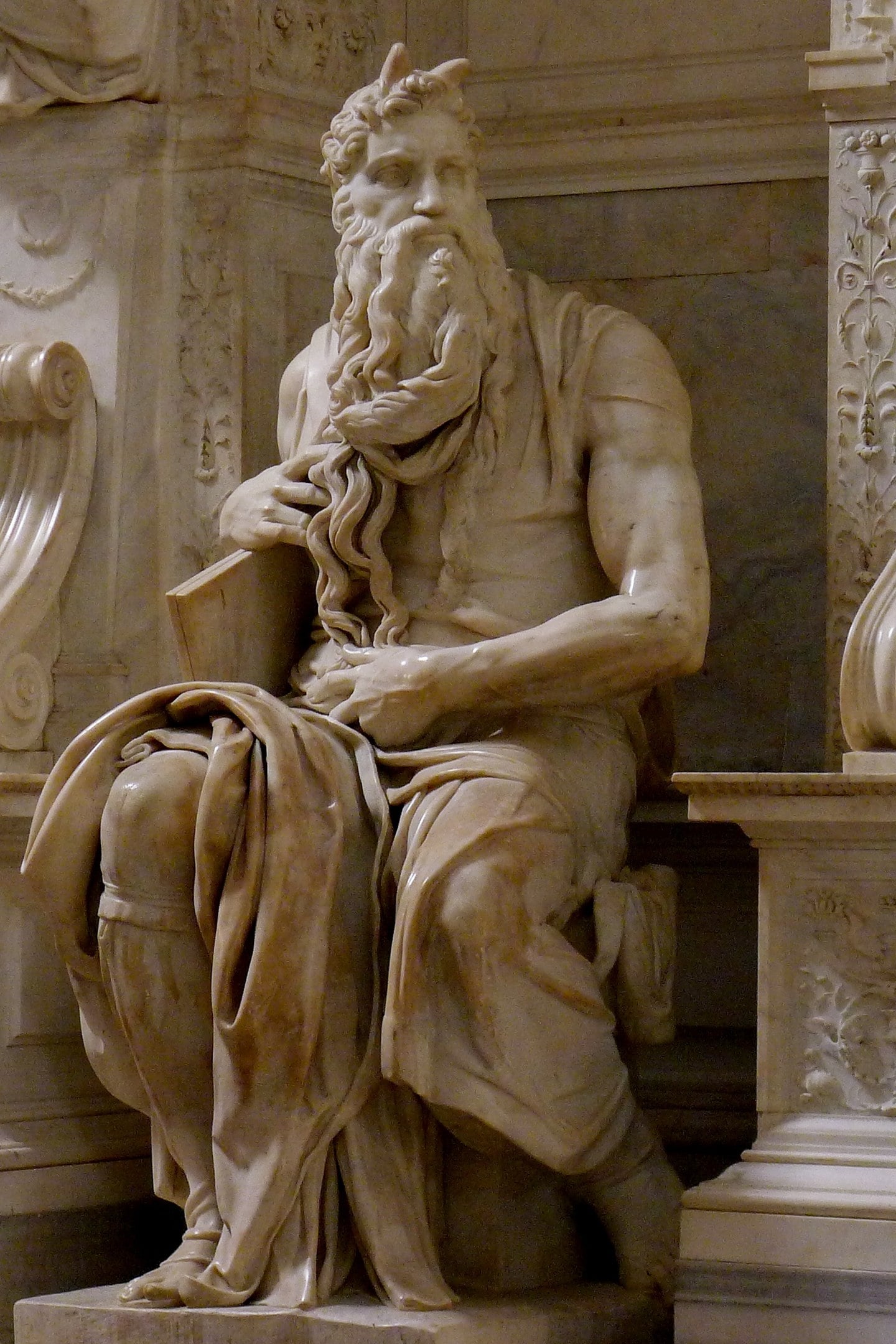 Moses, Michelangelo, c. 1513-1515
Moses, Michelangelo, c. 1513-1515However, the only piece that Michelangelo ever signed was his sculpture ‘Pietà’ (1498–1499), which depicts the body of Jesus draped over the lap of the Virgin Mary after the Crucifixion. This piece is important because it encapsulates the common theme of the Renaissance, natural beauty, while exhibiting hints of naturalism.
Michelangelo was also a great poet, his most famous piece being ‘The Doom of Beauty’. His poetry allows us a further insight into the mind of the artist.
3. Raphael (1483-1520)
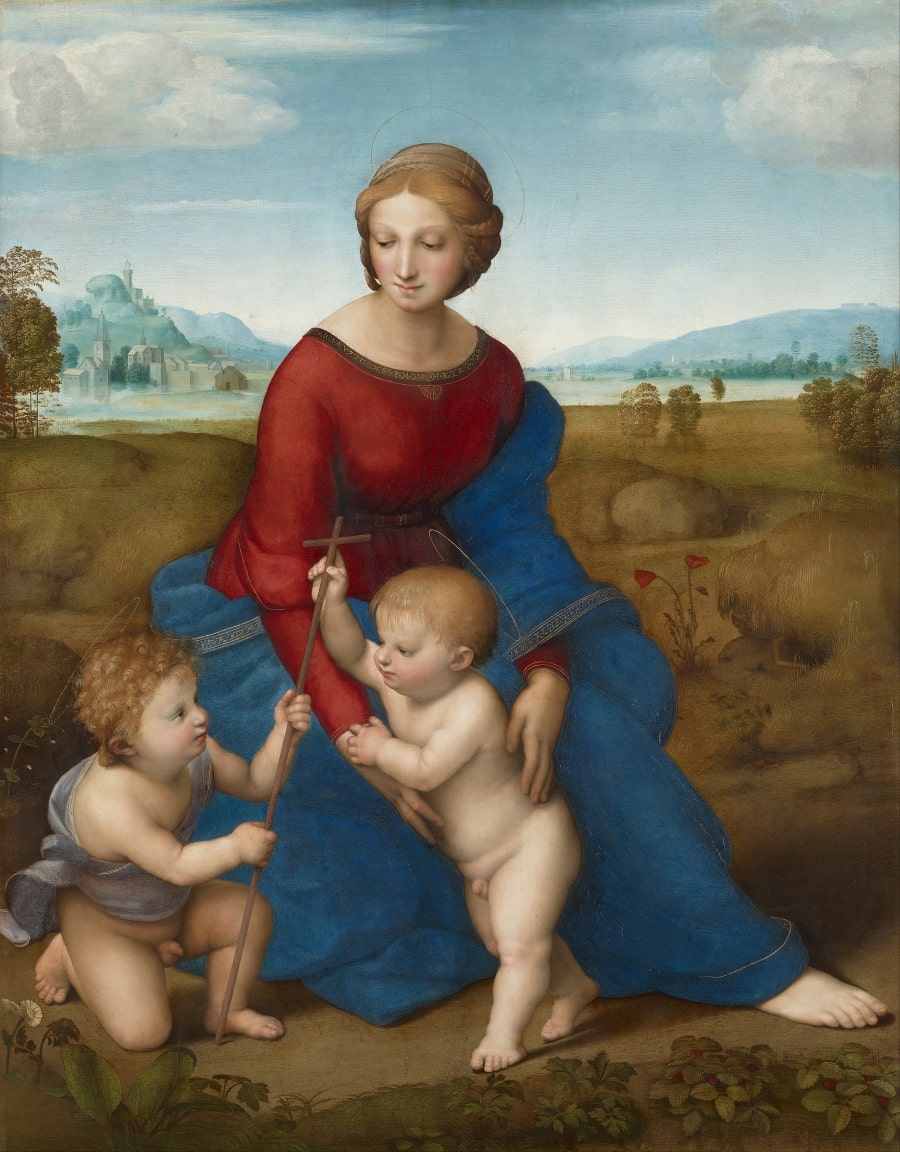 Madonna in the Meadow, Raphael, c. 1506
Madonna in the Meadow, Raphael, c. 1506Raphael, also known as rival to Michelangelo due to their similar artistic styles and projects, is an Italian painter, and architect of the High Renaissance period is most famous for paintings like:
- ‘Madonna in the Meadow’ (1506);
- ‘School of Athens’ (1511);
- ‘Sistine Madonna’ (1513).
An ambassador announced that Rapheal had painted the ceiling of the Sistine Chapel, when in fact it had been entrusted to young sculptor Michaelangelo, who wasn’t even a painter.
At the time of the painting of the frescoes on the ceiling of the Sistine Chapel, Raphael was commissioned to paint the walls of the Vatican. The Frescoes of The Stanza della Segnatura (1508 – 1511) are perhaps his most well-known works. They show a heavenly display of God and his prophets and apostles in an intricate geometric arrangement of images. The figures that Rapael painted are said to represent Philosophy, Poetry, Theology, and Justice.
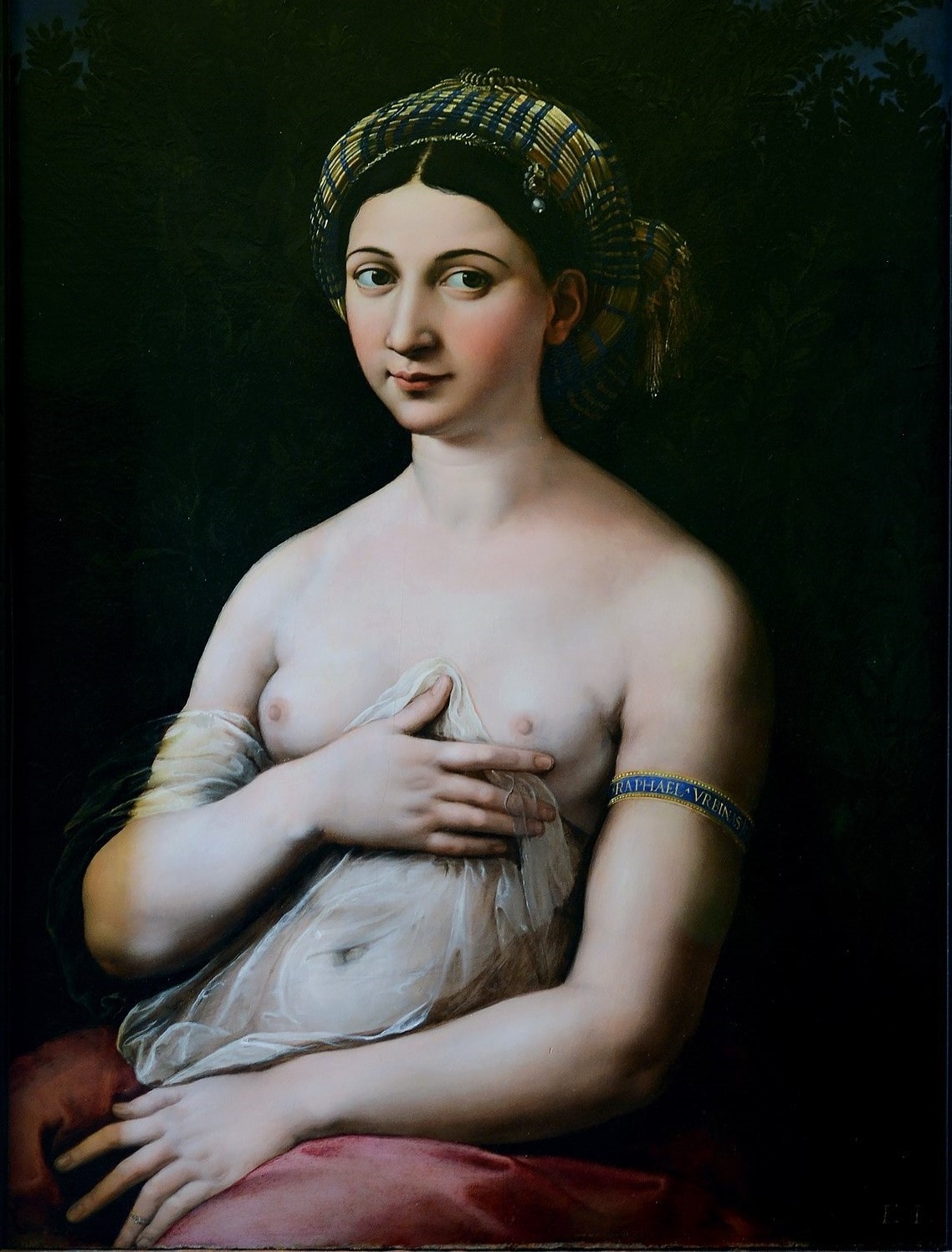 La Fornarina, Raphael, c. 1518 - 1519
La Fornarina, Raphael, c. 1518 - 1519He also often painted portraits of his lovers. ‘La Fornarina’ (1518 - 1519), in which a nude woman with a slightly amused smile is depicted covering her lower abdomen with a thin, transparent veil, is suggested to be Margherita Luti, his former lover who refused to marry him. Others claim that it is more of a representation of Raphael views of idealistic beauty.
He established himself as the most favoured artist in Rome when his work was met with high praise from Pope Julius II as it was said that his art encapsulated all of the qualities of harmony and idealised beauty that the High Renaissance was known for.
4. Peter Paul Rubens (1577-1640)
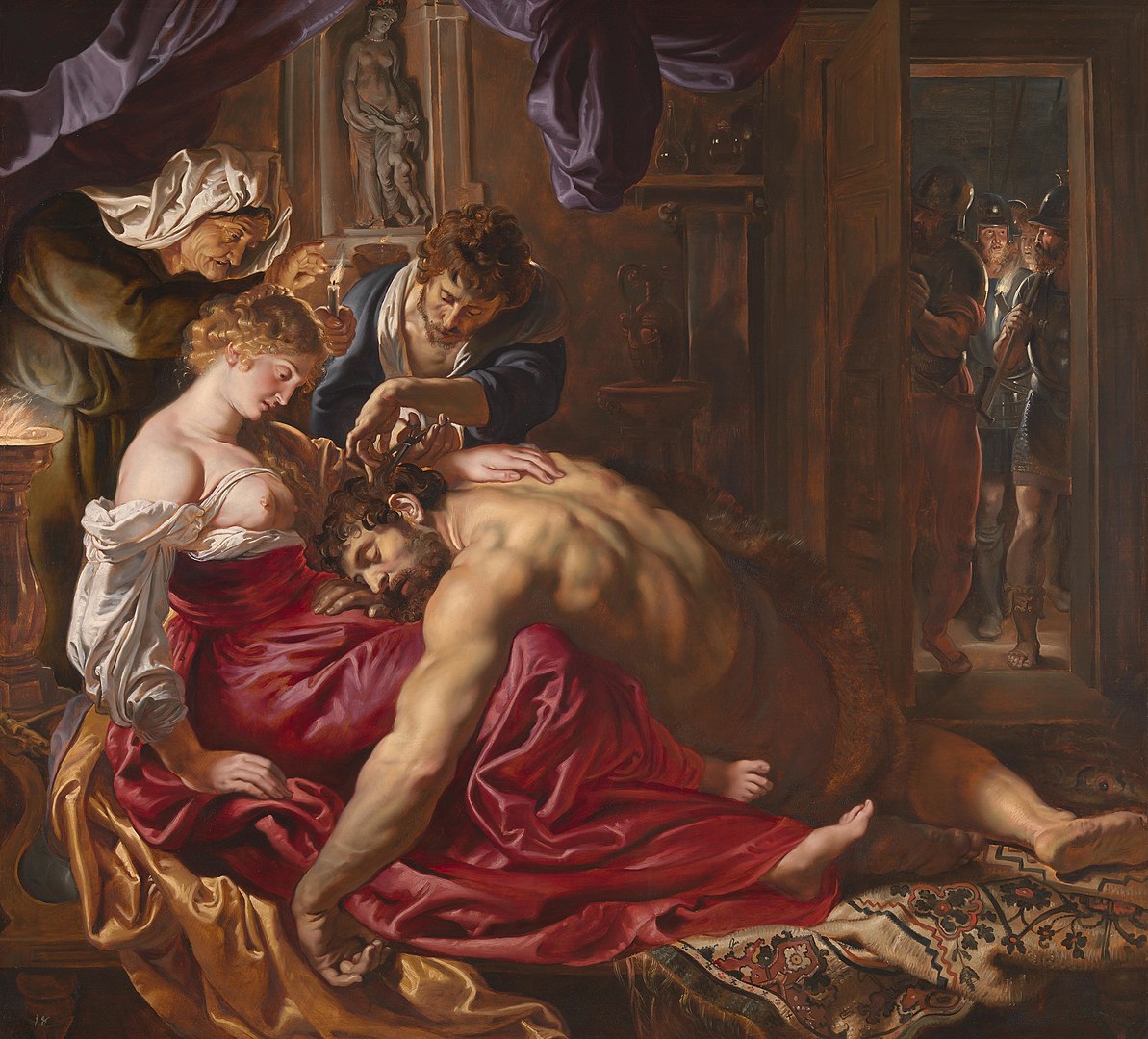 Samson and Delilah, Peter Paul Rubens, c. 1609-1610
Samson and Delilah, Peter Paul Rubens, c. 1609-1610A Flemish 17th-century painter, known for his altarpieces, portraits, landscapes, and history paintings of mythology and allegory. Rubens is considered to be one of the most influential artists of the Flemish Baroque tradition in northern Europe, renowned for his bold and expressive paintings. His paintings include:
- ‘The Elevation of the Cross’ (1610-1611);
- ‘The Judgement of Paris’ (1636);
- ‘Samson and Delilah’ (1609-1610).
His masterpiece ‘Samson and Delilah’ (1609-1610) depicts Old Testament hero, Samson, in the lap of his lover, Delilah, who is betraying him by observing her companion cutting his hair and therefore taking away his power of strength. You can view it at the National Gallery, London.
However, this painting has long been the subject of controversy: recent research performed by AI shows that this painting has a 91% probability of not being authentic artwork by Rubens. The algorithm, which analyses the unique brushstrokes of individual artists, givescritics reason to believe that the artwork is not authentic, an accusation that has long been suggested. It is believed that the painting in the National Gallery is a copy of the original piece which surfaced in 1929. This has undoubtedly created challenges in the accurate attribution of the artwork.
5. Rembrandt van Rijn (1606-1669)
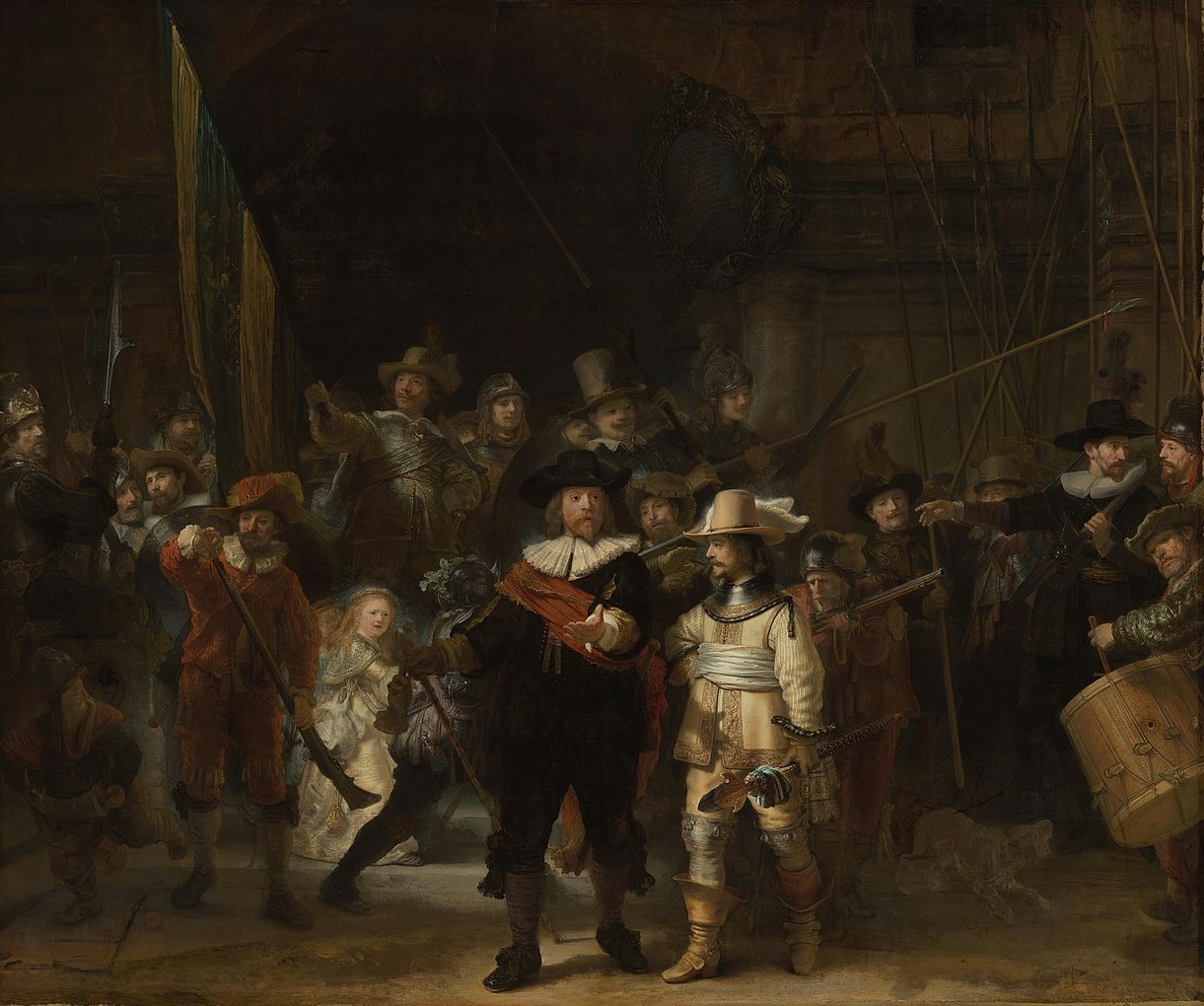 The Night Watch, Rembrandt van Rijn, c. 1642
The Night Watch, Rembrandt van Rijn, c. 1642Dutch Golden Age painter, printmaker, and draughtsman Rembrandt van Rijn is best known for his largest and most famous painting ‘The Night Watch’ (1642), which was made for one of the three headquarters in Amsterdam’s civic guard, who defended the city from attack. This made him the first to paint the guard in action, his use of light and shadow creating a sense of drama to a piece that otherwise would have appeared static and motionless.
Other famous works include:
- ‘The Anatomy Lesson of Dr Nicolaes Tulp’ (1632);
- ‘Danaë’ (1636).
These paintings show his range in artistic style, the first displaying public events in the 17th century of Anatomy lessons, the latter being a life-sized representation of a female character from Greek mythology.
He was also a great portrait artist, with nearly 80 portraits attributed to him. Each of which displays a slight change of appearance which is telling to gauge what is happening in his life in each moment of the portrait’s completion. For example, the ‘Self-portrait’ in 1659, illustrates the artist’s astute sunken eyes as a result of the financial failure that he had suffered. His portraits show how his expressions change from a young artist, in his twenties until the age of 63.
His use of chiaroscuro, the use of contrasting effects between light and dark, adds dramatic effect to his pieces. His work was noticeably inspired by Caravaggio who had developed a dramatic chiaroscuro technique known as tenebrism, in which many of his figures appear to be spotlighted due to the stark contrast between them and the inky black backdrop.
6. Johannes Vermeer (1632-1675)
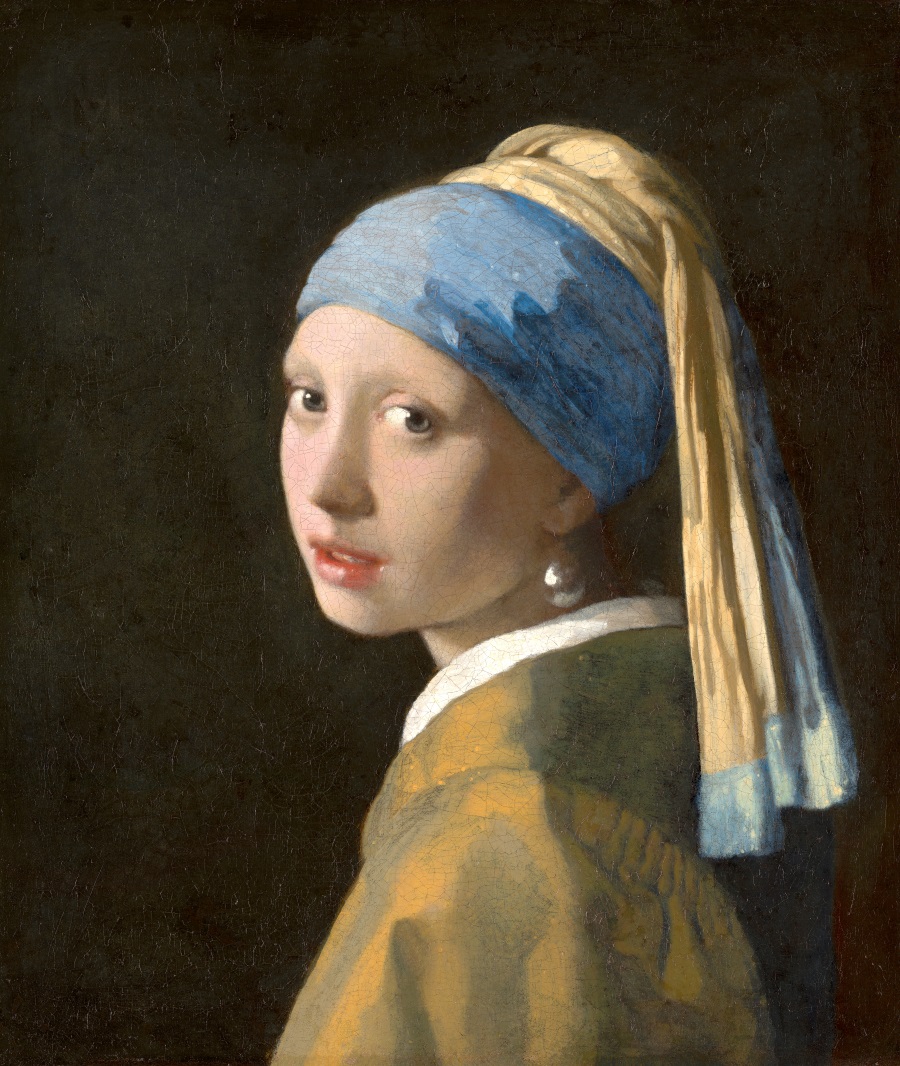 Girl with a Pearl Earring, Johannes Vermeer, с. 1664–1667, oil on canvas. Mauritshuis, The Hague. Bequest of Arnoldus Andries des Tombe, The Hague
Girl with a Pearl Earring, Johannes Vermeer, с. 1664–1667, oil on canvas. Mauritshuis, The Hague. Bequest of Arnoldus Andries des Tombe, The HagueVermeer’s new show at the Rijksmuseum in Amsterdam has been referred to as the “chance of a lifetime” by its curators. The show, which is running until June 4, showcases 28 of Vermeer’s known 35 paintings, exhibiting Vermeer’s important role in the Golden Age of Dutch-art.
Known for his paintings of domestic interior scenes of middle class life, Vermeer was a moderately successful provincial genre painter, but his most famous piece is ‘The Girl with the Pearl Earring’ (1665), now housed in The Hague in the Netherlands.
His other famous paintings are:
- ‘Girl Reading a Letter at an Open Window’ (1657-1659);
- ‘Young Woman with a Lute’ (1662-1663);
- ‘Young woman sleeping’ (1657).
All of the above unconventionally portray female characters in everyday tasks creating an inviting insight into the interiors depicted in his paintings.
His art is featured in museums all over the globe, and four of his pieces are held in The Rijksmuseum in Amsterdam, where you can currently also see the major Vermeer show until June 4, 2023.
7. Claude Monet (1840-1926)
Claude Monet once said:
Colour is my day-long obsession, joy and torment,
A French painter considered to be one of the founders of impressionism, his work is seen as an antecedent of modernism. Illustrating perceptions of light and nature, the process of depicting outdoor landscapes is named ‘plein air’ painting. The blurred nature of his pieces and obscured brushstrokes capture the innate nature of light and shape, to give only an impression of what he saw, hence the influence for the name of the artistic movement. His artistic style was seen as innovative in the Parisian avant-garde art scene.
The highlight of Monet’s career was ‘Water Lilies’ (1899), a series of 250 oil paintings, his main focus in the last 30 years of his life which he painted whilst almost blind. The large panels of the ‘Water Lilies’ were installed in the Orangerie Museum in Paris a few months after his death, and remain there to this day. Most of his painting collection can be viewed in The Musée Marmottan Monet in Paris.
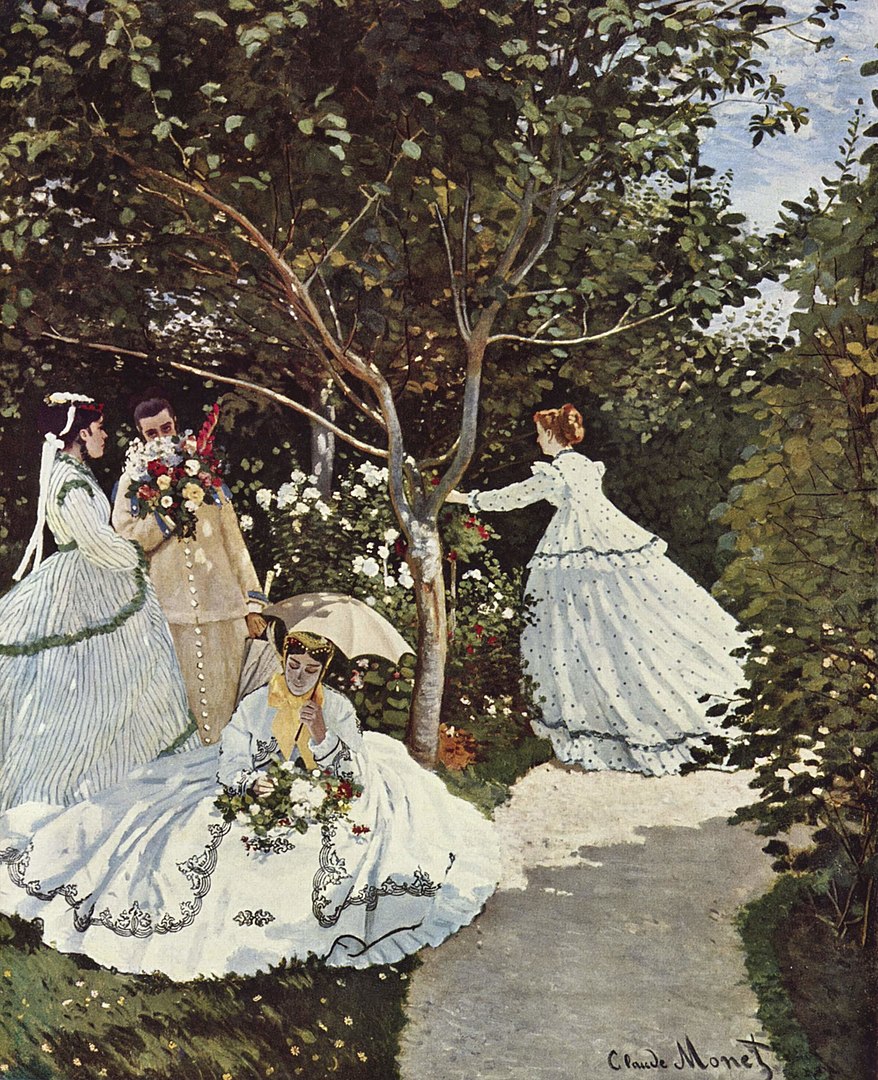 Women in the Garden, Claude Monet, c. 1866
Women in the Garden, Claude Monet, c. 1866Other famous paintings include:
- ‘Women in the Garden’ (1866);
- ‘Waterloo Bridge, London’ (1903).
‘Waterloo Bridge, London’ (1903) is part of a well-known series of paintings, ‘Waterloo Bridge, effet de brouillard’ (1889-1903), which depict the changeability of lighting and colouring in London landscapes due to the fog and unpredictable English weather. Monet layers colours such as pinks, purples, oranges and whites with blues and greys to create dynamic images of the stone bridge and the shadows it casts over the River Thames. The artist worked on the multiple canvases simultaneously to try and capture the unforeseeable changes in light and colour of the subject.
His country house and gardens in Giverny are open to the public in which you can see the real-life inspiration of beauty behind Monet’s paintings. The two parts of Monet's garden contrast and complement one another, there is a flower garden, ‘Clos Normand’ at the front of the house and a Japanese-inspired water garden. Most of the features of the garden were planted by Monet himself to provide himself with a beautiful, natural muse for his paintings.
8. Vincent van Gogh (1853-1890)
A Dutch post-impressionist painter and one of the most famous and influential artists of Western history to date, Vincent van Gogh created over 2000 artworks throughout his life, including 860 oil paintings. His most famous paintings include:
- ‘The Starry Night’ (1889);
- ‘Self-Portrait’ (1889);
- ‘Vase with Fifteen Sunflowers’ (1888).
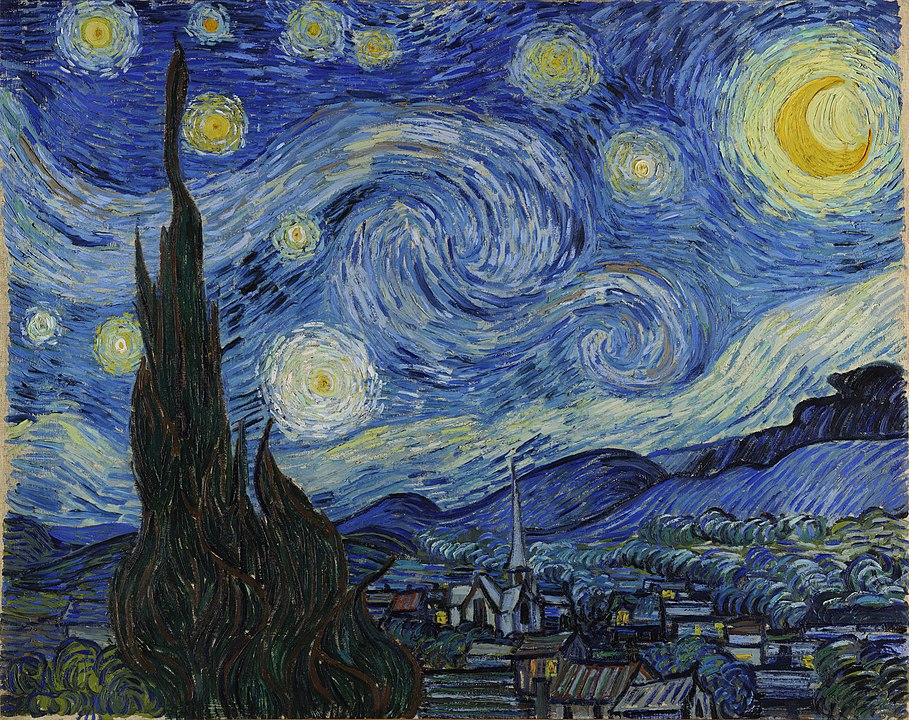 The Starry Night, Vincent van Gogh, c. 1889. Museum of Modern Art
The Starry Night, Vincent van Gogh, c. 1889. Museum of Modern ArtArt experts have wondered what the inspiration was behind ‘The Starry Night’ painting. The towering cypress trees have always been ambiguous in what they must represent. Many critics have interpreted them as abstract figures looming over the hillside village in the background, while others view them as a transcendental depiction of nature.
However Professor James Hall, a former Guardian art critic, has recently provided a new explanation, suggesting that these cypress trees in the foreground, in fact, represent the Eiffel Tower. The date of the painting, 1889, correlated with the unveiling of the renowned Parisian landmark, which consisted of a spectacular fireworks and lights display. The swirling night sky with bursts of bright yellow and white strokes of light is reminiscent of this event. The cypress trees are large and dominating over the city in the background, much like the towering structure of the Eiffel Tower.
His pieces are scattered in various museums around the world, but his most extensive collection of art can be found in The Van Gogh Museum in Amsterdam. Various immersive experiences across the world, in cities such as Singapore, Milan, Brussels, and London, where you can “step into” his paintings to take a closer look at his work.
9. Pablo Picasso (1881-1973)
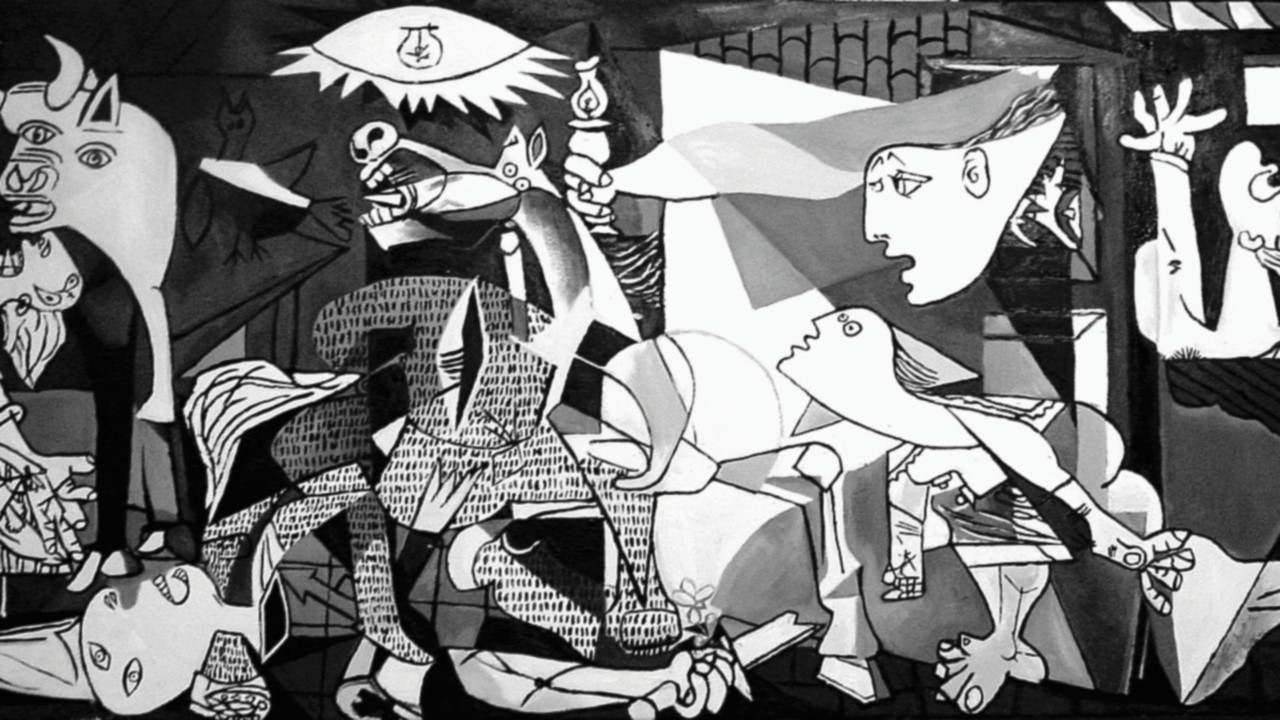 Guernica, Pablo Picasso, c. 1937
Guernica, Pablo Picasso, c. 1937Picasso’s most famous piece, and one of the most famous in the world, of course, is ‘Guernica’ (1937) , regarded by many art critics as the most powerful anti-war piece in art history, housed in Museo Reina Sofía in Madrid. This piece was painted in response to the carpet-bombing regime put into force by Francisco Franco in 1937, when they bombed a village in Northern Spain called Guernica. Picasso wanted to address the injustice of bombing innocent civilians. The expressions and images depicted in ‘Guernica’ show the horrors of this genocide that was committed and the suffering it causes among blameless individuals.
A Spanish painter, sculptor, printmaker, ceramicist and theatre designer who never stopped pushing boundaries to reinvent his artistic style, Picasso’s works significantly contributed to the development of modern art in the 20th century, especially through his exploration of cubism.
His other paintings include:
- ‘The Weeping Woman’ (1937);
- ‘The Old Guitarist’ (1904).
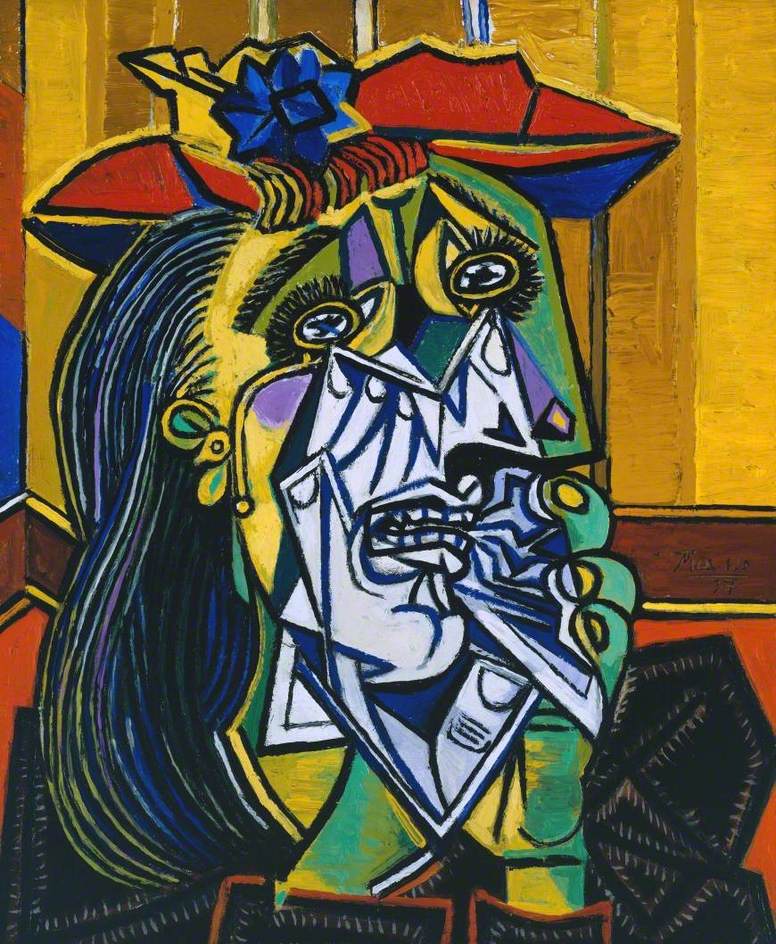 The Weeping Woman, Pablo Picasso, с. 1937
The Weeping Woman, Pablo Picasso, с. 1937‘The Weeping Woman’ (1937), is based on the image of a woman holding her dead child taken from ‘Guernica’. The use of mismatched colours and irregular lines illustrates the feeling of intense grief that she must feel. ‘The Old Guitarist’ (1904), meanwhile, is a painting which represents Picasso’s criticism of society, the guitar being the only part of the piece in colour, showing the despair and desperation of the man due to the extreme poverty he is experiencing, with the only hope he has for survival being this instrument.
10. Salvador Dalí (1904-1989)
 The Persistence of Memory, Salvador Dalí, с. 1931
The Persistence of Memory, Salvador Dalí, с. 1931As well as painting the surreal and the obscure, Dalí had a pretty unusual life himself. He was able to tap into his subconscious developing what he called a “paranoiac-critical” method, which consisted of an induced state of paranoia in which he was able to view the world in a subjective way to conjure links between everyday objects and the surreal.
Dalí is known for his technical skill in the precise, prominent, and unconventional images seen in his work, Dali is renowned for his iconic moustache and extravagant persona as well as his creative output that is said to have contributed greatly to the surrealism movement of the 20th century.
His most renowned artworks include:
- ‘The Persistence of Memory’ (1931);
- ‘Swans Reflecting Elephants’ (1937);
- ‘Soft Construction with Boiled Beans’ (1936).
Most of the Dalí curated collection is housed in The Dalí Museum (St. Petersburg, Florida).
‘The Persistence of Memory’ (1931) was created when Dalí had been thrown out of his family home by his father. Dalí moved into a shack in a fishing village nearby, in which he was poverty-stricken but inspired by the landscape of the nearby Mount Pani. Many art critics have questioned whether the clocks featured in this renowned painting were motivated by the Theory of Relativity by Einstein, but Dalí denies this and claims that they were inspired by a melting Camembert cheese he watched lose its circular form in the sun.
As an Art de Vivre subscriber, keep deepening your knowledge of art and learn more about world's most expensive paintings.
Photo Credits: Wikipedia Commons

